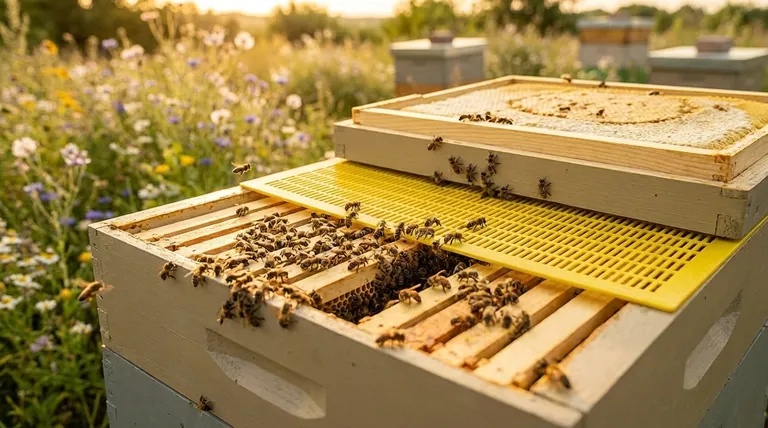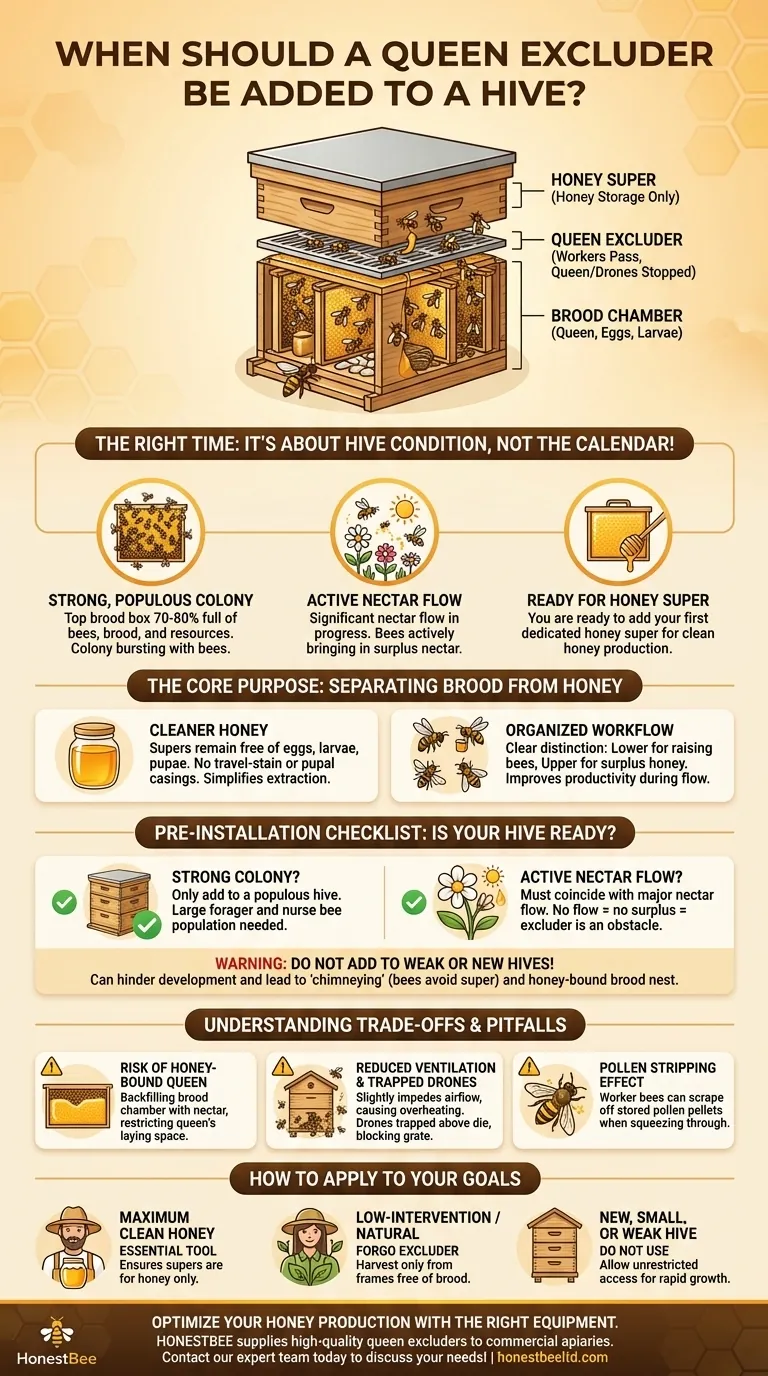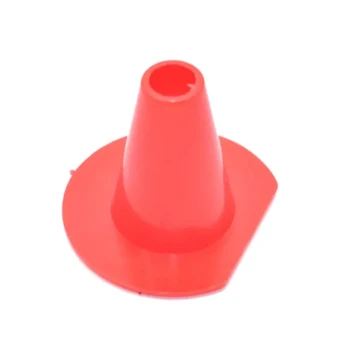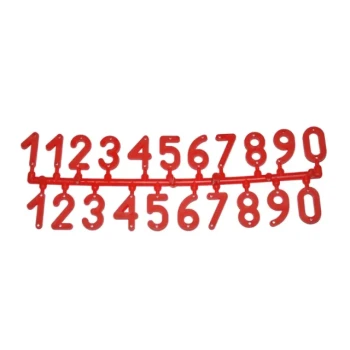The right time to add a queen excluder is not based on a calendar date, but on the specific condition of your hive. You should only add an excluder when a colony is strong and populous, there is a significant nectar flow in progress, and you are ready to add your first dedicated honey super. Adding it too early to a weak hive can hinder its development and workflow.
A queen excluder is a strategic tool, not a mandatory piece of equipment. Its purpose is to ensure honey supers remain free of brood, which requires adding it only when a hive is strong enough to expand and actively bringing in nectar.

The Core Purpose: Separating Brood from Honey
What a Queen Excluder Accomplishes
A queen excluder is a simple grate with openings large enough for worker bees to pass through, but too small for the larger queen and drones.
Its sole purpose is to confine the queen to the brood chamber (the lower boxes of the hive), preventing her from laying eggs in the honey supers above.
The Benefit of a "Honey-Only" Super
By keeping the supers free of eggs, larvae, and pupae, you ensure the frames are used exclusively for storing honey.
This results in cleaner honey, free from the pupal casings and travel-stain that accumulate in brood comb. It also simplifies the extraction process, as you don't have to work around patches of brood.
Organizing the Hive's Workflow
This separation creates a clear distinction within the hive: the lower boxes are for raising new bees, and the upper boxes are for storing surplus honey. This helps organize the colony's efforts and can improve overall productivity during a strong nectar flow.
Pre-Installation Checklist: Is Your Hive Ready?
Before you even touch an excluder, you must verify that the hive meets two critical conditions. Adding an excluder to a hive that is not ready can do more harm than good.
Condition 1: A Strong, Populous Colony
An excluder should only be placed on a hive that is bursting with bees. A good rule of thumb is that the top brood box should be 70-80% full of bees, brood, and resources.
The colony needs a large population of forager bees to cross the barrier and a sufficient number of nurse bees to manage the brood nest below.
Condition 2: An Active Nectar Flow
The timing must coincide with a major nectar flow, when local flowers are blooming and bees are actively bringing in large amounts of nectar.
Without a flow, there is no surplus honey to store, and the excluder simply becomes an unnecessary obstacle that can disrupt the colony's movement.
Why Weak Hives Should Not Have an Excluder
Placing an excluder on a small or weak colony is counterproductive. The bees may see it as a barrier and be reluctant to move up into the supers, a phenomenon known as "chimneying." This can lead to the colony becoming honey-bound, where they fill the brood nest with nectar, leaving no room for the queen to lay.
Understanding the Trade-offs and Common Pitfalls
While useful, a queen excluder is not a perfect tool. Understanding its potential downsides is crucial for effective hive management.
The Risk of a "Honey-Bound" Queen
If workers are slow to move through the excluder, they may store incoming nectar in the brood chamber instead of the supers. This "backfilling" can quickly restrict the queen's laying space, reducing the production of new bees and potentially harming the long-term health of the colony.
Reduced Ventilation and Trapped Drones
An excluder can slightly impede airflow, which can contribute to overheating and "bearding" (bees clustering on the outside of the hive) on hot days.
Furthermore, drones cannot pass through the excluder. If drones hatch from a frame moved above the excluder, or if drone brood was already present, they will become trapped and die, blocking the grate for worker bees.
The "Pollen Stripping" Effect
As worker bees squeeze through the narrow slots, they can sometimes scrape off the pollen pellets stored in the baskets on their hind legs. While not a catastrophic loss, it is a known inefficiency associated with excluder use.
How to Apply This to Your Project
Your decision to use an excluder should align with your specific beekeeping goals.
- If your primary focus is producing the cleanest possible honey for sale: An excluder is an essential tool for ensuring your honey supers are never used for brood rearing.
- If your primary focus is low-intervention or "natural" beekeeping: You may choose to forgo an excluder and manage brood by harvesting honey only from frames that are completely free of eggs and larvae.
- If your hive is new, small, or recovering from weakness: Do not use an excluder. Allow the colony unrestricted access to all boxes to encourage rapid growth and expansion.
Ultimately, view the queen excluder as a specialized instrument to be used only when the conditions are right to achieve a specific management goal.
Summary Table:
| Condition | Indicator of Readiness | Risk if Added Too Early |
|---|---|---|
| Colony Strength | Top brood box is 70-80% full of bees, brood, and resources. | Hinders hive development; risk of chimneying and becoming honey-bound. |
| Nectar Flow | Active, significant nectar flow is in progress. | Excluder becomes an obstacle with no surplus honey to store. |
| Goal Alignment | Ready to add first dedicated honey super for clean honey production. | Unnecessary for weak, new, or low-intervention hives. |
Optimize your honey production with the right equipment. HONESTBEE supplies commercial apiaries and beekeeping equipment distributors with high-quality, durable queen excluders and other essential beekeeping supplies through our wholesale-focused operations. Let us help you manage your hives more effectively for a cleaner, more productive harvest. Contact our expert team today to discuss your needs and place your order!
Visual Guide

Related Products
- Professional Plastic Queen Excluder for Modern Beekeeping
- High Performance Plastic Queen Excluder for Beekeeping and Apiary Management
- Premium Wood Framed Metal Wire Queen Bee Excluder
- Metal Queen Bee Excluder for Beekeeping
- 8-Frame Electric Self-Reversing Honey Extractor Spinner for Commercial Honey Extraction Equipment
People Also Ask
- What is a Queen Excluder and how does it work? Achieve Purer Honey & Better Hive Control
- What are the pros of using a queen excluder? Boost Hive Control & Honey Quality
- What is the role of a queen excluder when adding a super? Ensure Brood-Free Honey Harvests
- What are the main advantages of using a queen excluder in beekeeping? Simplify Hive Management & Harvest
- What is the purpose of a queen excluder when adding a super? Streamline Your Honey Harvest



















